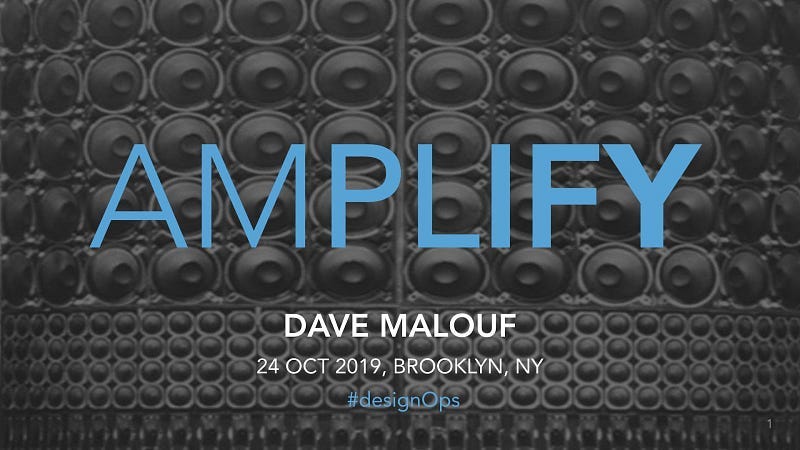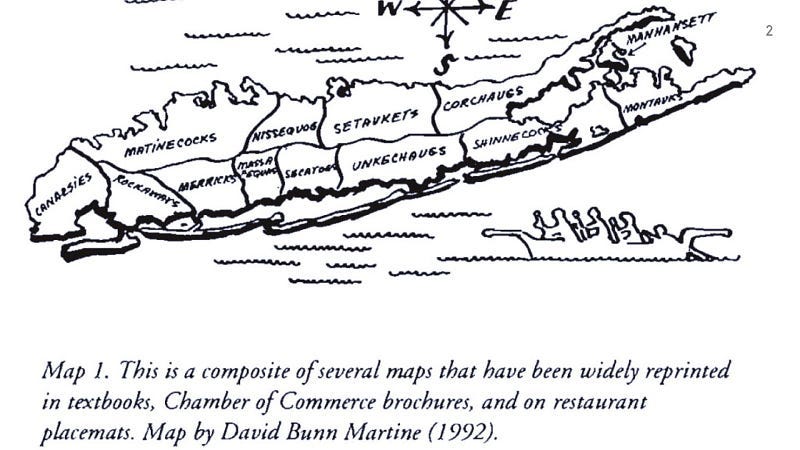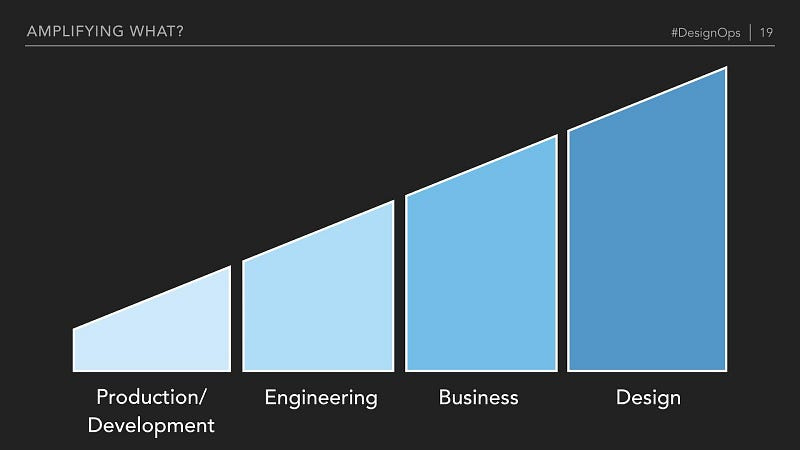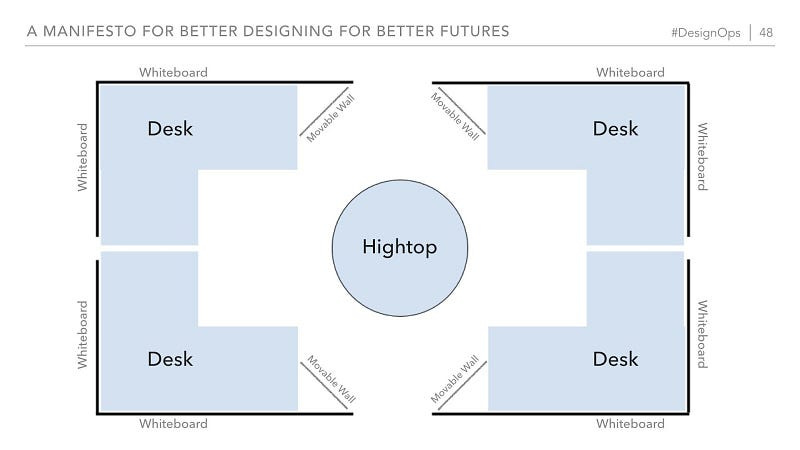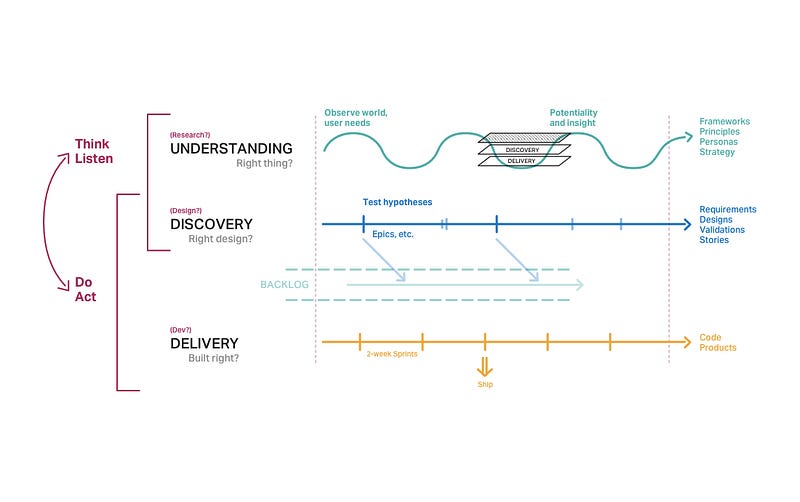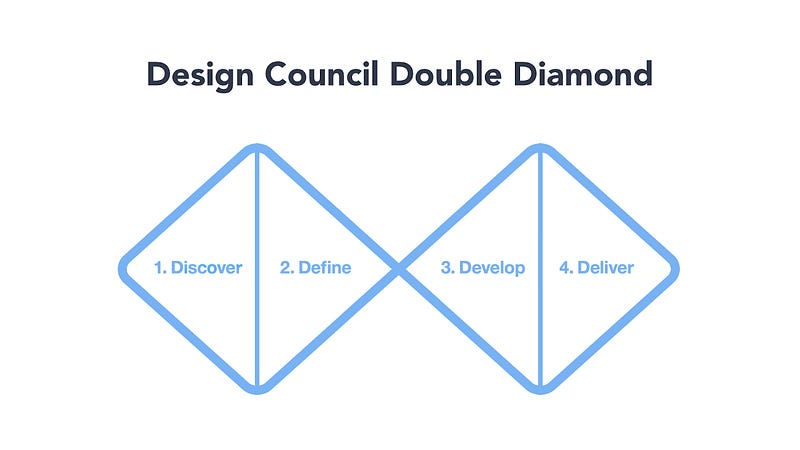Design Operation’s Core Mission to Amplify the Value of Design Practice.
Closing Keynote @ DesignOps Summit
24 October, 2019
Brooklyn, NY
#DesignOps
Full deck on Slideshare.
Amplify
Hi everyone, I’m really excited to be giving this talk to you all.
Land Acknowledgment
We want to acknowledge that we gather now on the traditional land of the Canarsie and Lenape Peoples past and present, and honor with gratitude the land itself and the people who have stewarded it throughout the generations. This calls us to commit to continuing to learn how to be better stewards of the land we inhabit as well.
Land Acknowledgment
We make this acknowledgement to …
Remember how we remain benefactors of colonization in using this land.
Remember the people who are no long here to tell their pre-colonial histories.
Begin the process of decolonization.
Land Acknowledgment
We understand that this gesture of acknowledgment is a first step in our own education of the land and traditional peoples that we occupy today, and those who’s colonization bore us benefit also from afar, and how we continue that mindset of inequality unconsciously and consciously, passively and actively in the present.
Amplify
Ok, now let’s start with a little thought experiment. Close your eyes. Don’t worry you don’t have to look at me, I’m here for the next 25min for sure. You’ll have a second chance. I want to ask yourselves.
Why are you a design operator?
Forget if we all agree what that even means. You are here. You’ve made some commitment to be here hoping that somehow design operations had value to you. So why? Why are you a designer operator?
I mean how often have we ever asked ourselves why we’ve ever been anything before? Most of us probably came to DesignOps from very different paths, and our reasons for sticking with it (for now) are probably really different from each other.
My Story
Chapter 1:
IxDA is born
Pratt & the spirit of Roweena Red Kostellow fill my soul
So, here is my story.
For me it started when I fell in love with design. It was 2003, IxDA had just been conceived and whole new types of people were beginning to enter my circle, not least of which were Industrial Designers & Architects. I became so intrigued by this path to interaction design, that I decided to go to night school in Industrial Design at the Pratt Institute here in Brooklyn. While there, I fell in love with design. Studio-based design filled me all the way to my bones. Foundational aesthetics to solutioneering. It all resonated strongly. But quite honestly I was never able to break past my severe lack of hand-eye coordination in both drawing and model-making. But damn! I loved the *power* of design. Whatever the heck that meant.
I spent the next decade immersing myself in industrial design but as an interaction designer. I gave up on going to ID school as a student quickly, but then found myself as an interaction designer in an award winning industrial design studio and it was there that I had my first glimpse into really what it means to think operationally about design practice.
I learned that the quality of design was greatly impacted by workflow, tools, and governance even as much if not more than whether or not our craft and methods were top notch.
Gulfstream Center for Design of the Savannah College of Art and Design
After Motorola, I entered this building for the 2nd half of that decade. Savannah College of Art and Design’s Gulfstream Center for Design.
This is where Industrial Design, Furniture Design, Marine Design, Service Design, Design Management, Design for Sustainability, and my little world of Interaction Design were all taught. I was a professor here and I learned so much more from my students than I ever taught them (some might even be here probably nodding along).
This was one of my students. I could never do what he did. He could make forms shine, not just literally like this boat he built from scratch, but graphical forms, too. He could do that because he had aptitude for sure, but also because he was being taught in an environment that from soup to nuts was set up for him to succeed.
To create a project like this digital speculative design prototype, meant giving students access to dedicated space, materials (literally), green screen filming capabilities, access to CG tools, and time (not nearly enough of it), to conceive story, characters, and contexts. And this all after they spent weeks doing the research.
This is where I became in love with my real calling, which isn’t being a designer, but being a design amplifier.
I was a teacher, yes. But more than being a teacher, I loved helping OTHERS make great design, better design, more impactful design.
From this point forward my career took twists and knots and too long after I found my real calling as a Design Operator, a Design Amplifier.
What am I amplifying?
Version 1
If I’m an amplifier, what is it that I’m amplifying?
If I am amplifying design value, I should know first what design’s value is, right?
Amplify: turn it up to 11
Here’s the interesting thing.
Design’s value is that design amplifies. It brings everyone else to 11 if it is allowed to.
Let’s dig a little deeper into this.
The Stool
We have been understanding the context of a lot of our work with this piece of furniture — the stool. Or some 3 circle Venn diagram.
It assumes that if all 3 pieces are in harmony we will have balance (a stool), or a sweet spot of a Venn diagram.
But the reality is that there is no real balance, that is if we were to look at this from the perspective of value.
First there is production — construction
— building.
There is no value without anything being built.
Then engineering comes in to plan, architect, and yes, even design solutions to be even longer lasting, more sustainable, more performant, etc.
But Engineering and production need the business, to give it purpose and to package it in a way that makes it more easily accessible, understandable, and indeed valuable.
And then there is design … Design for its part helps everyone in this cone and more. It amplifies every other piece of the value chain when allowed to by bringing in different mindsets, different skillsets, different modes of working, etc.
But to be clear from the point of view of customer value they don’t create anything unique. The ways of creating may be arguably unique and the ways of doing are it’s ultimate value as an amplifying force.
Design is a team sport.
Designers can’t work only as designers if they are going to be amplifiers.
And designers are not even the drivers of the system.
The designer in the above picture isn’t even in this picture.
This amazing team is all 100% executioners with different roles.
Each one made better — their value amplified through design, and that design amplified through operations.
What am I amplifying?
Version 2
If I’m a design amplifier, what is it that I’m amplifying? (again)
What makes good design amplification happen? What makes good design happen?
Great Design happens because of great designing.
So what does it mean to design well?
What are the activities of design practice that amplify value of others?
We need to understand these things because, this is what the Design Operator is amplifying.
1. Form giving
If there is any beginning to design activity from an evolutionary perspective it is
Form giving. Design gives form.
But this isn’t just about executing forms.
Sketching> quickly is a key form giving technique that creative people of all types rely upon.
Graphic models> help us understand systems, data, flows, etc.
3D Forms> or other prototypes allow us to experience possibilities and make discoveries.
This one is an interaction design student project where they built out “digital” display signs for a big box electronics store, so they could test out physical gestures with RFID hardware. Is it tap, wave, or insert that worked best?
Wherever forms are made, designer value begin to add value
Because of the foundations in understanding forms that designers not just learn academically,
But put to craft and critique:
Line, layout, composition, color, type,
Texture, volume, negative space
Juxtaposition, alignment, flow
2. Clarity
Next up is clarity. Clarity is communicated in the forms and the language, whether for the designs themselves or the artifacts that are used to help understand how, what, and why of the design ecology.
It is also about the clarity we gain from structure, relationships, navigation — Yup, Information Architecture
3. Behavioral Fit
Designers also bring behavioral understanding to life through the behaviors of the systems we design. What are the behaviors in our culture that are comfortable, not awkward. What makes a behavior awkward? Where is friction in a set of behaviors? How can those frictions be reduced, be made to feel delightful? Forms tells us what is possible as much as it helps us understand the value of that possibility.
Recently I’ve been traveling internationally more and the border crossings at airports are becoming pretty darn sophisticated. They enable so much greater flow with minimal invasive behaviors.
In Hong Kong, Sydney, Singapore the use of retinal scans, fingerprint scans, and facial image recognition make airport passport controls practicality seamless.
Pairing AirPods or Beats to your iPhone is just amazing.
Similarly good behavior is how iMessage will capture a code that comes in via text message and make it available for auto-populate in an app later in the autocomplete part of the keyboard for most 2FA processes.
Or how easy it is to share WiFi passwords between devices that share the same iCloud ID.
These are all examples of common flows across devices and systems that either Apple controls, or has invented a way to design the behavior of their software to FIT the behaviors of people AND other systems.
4. Exploration
This is probably my favorite aspect of design practice.
Of course, other explore, but not quite the way that designers explore.
And exploration is very different from experimentation.
Experiments are about finding truth through validation.
Exploration for designers is not about finding truth. Rather it is about discovering possibilities.
One of the most important and most used forms of exploration is through sketching.
It works best through multiplicity of rough renderings.
Only through the process of using the exploration of ideas as the starting point for making connections that previously could never have been made without initial creation and subsequent juxtaposition.
Exploring stories possible futures without having to build anything help us to understand contexts, possibilities, and evaluate them further, deeper, after confidence is gained.
So why did I just give what for some might feel like an Intro to Design lesson?
Well, the first reason is that a little less than half of you were not designers in part of your career before you were design operators. And while that is not a requirement for being a solid design operator, it does mean just like designers have to learn about operations, design operators without design training have to learn some level of literacy of design practice along the way.
Welcome to Stockholm … Syndrome
Second, many of us today have Stockholm Syndrome.
Designers have lived at the whim and will of product & development folks.
We have been told again and again we have to speak their language to work with them.
We have to measure ourselves the way they want to be measured.
We have to use their methodologies.
In so doing we have stopped working in the ways that have traditionally provided the most value to the organizations we’ve worked for.
We have learned a few things along the way so it hasn’t been all bad by any means.
What and how to build
Agile Manifesto
Raise your hand if you have read the agile manifesto?
So much of my journey to becoming an operator has forced me to do so repeatedly over the last 5 years. Agile has just never sat well with me. So as I felt compelled to compromise for sanity and good well, I wanted to be clear about what I’m compromising for and with.
What is here is a manifesto about “how to develop software”.
Not a way to develop requirements
Not a way to understand contexts for software to be used
Not a way to deliver better value to users.
And the common interpretations of agile in Scrum are even more focused on delivery of constructed objects, than on the creation of viable, feasible, and valuable requirements that impact holistic systems.
These things are not all bad, but they are not things that help design happens better.
Speaks to the optimizers
This framing of how to make “good software” speaks directly to the spreadsheet.
The abacus, the calculator … to factory managers.
It is framed for speed and recovery (more speed).
Instead of depth, purpose, and vision.
It isn’t ironically not even framed to create more value.
What if we asked a different question?
As design operators shouldn’t we be asking ourselves a different set of questions?
How might we make design happen better?
Design Operator’s Prime Directive
Here’s one that I would like us to tackle and take on as a new prime directive of Design Operator’s practice.
Design Happens Better When …
A Manifesto for Better Designing for a Better Future
Together and separately each one of these is meant to support the form giving, providing clarity, creating behavioral fit, and doing exploration.
Our role as design operators is to enable and support all 7 (and more like them) that you can come up with.
But how? How does this guide us as operators any differently from what we’ve been doing already?
Let’s go through each one and see how it impacts our work as operators.
Different activities happen at their most appropriate cadence.
Right size your workflow structures
Wholes need to be created before parts
This means you can’t always chunk stuff
This is a direct counter to most implementations of agile — scrum, SAFe, similar — that focus on “the sprint”.
Time-boxing, which is the general principle in agile doesn’t say that everyone on a team needs to be in the same cadence at all. And proposed processes like dual-track and methods like kanban give flexibility for teams to find their own way.
A recurring theme in my research is that design is best when designers build “wholes”.
This means either building a whole collection of ideas to derive connections and see patterns in or create a complete story from which they can deconstruct concepts from again to make new connections to form new ideas with. So the cadence needs to be designed against the estimates for framing a “whole”.
Intentional spaces & processes encourage serendipity, emergence, exploration
Space to externalize work.
Either virtual or physical,
but always availableTime & space away for reflection,
play, just experiencing.
Space is probably one of the hardest things for us operators to provide the people whom we work for and with.
But space is probably one of the most underestimated valuable pieces for amplifying the work of designers. The right space like a cone shape for a speaker, amplifies connections on so many levels: objects & artifacts, but probably equally important is that the right space connects people.
One of my favorite set ups for space looks like this:
This is a team pod.
It could be all designers. But it could be a part of a squad. You can adjust it for different numbers of people. I have found 4 to be a good size b/c you can control noise more.
The black lines are walls. The desks face the walls. This helps focus, but also lets others get line of sight to work in progress. The walls above desks are magnetic whiteboards where thinking and work can be externalized for longer periods.
The hightop in the middle encourages ad hoc collaboration, review, and critique sessions.
Lastly, there are movable walls in the corners to be used w/ the hightop or to help create even more focus for individuals or both at the same time.
A balance of both quantitative & qualitative data are synthesized into actionable insights.
Methods for collecting the right data
need to be native to the design process.Instrumentation needs to be built to
capture appropriate data.Dashboards & repositories need
to be used to turn data into
actionable insights.
The most important part of this set is the moment of transition.
We need actionable insights to come from whatever sources and types of data is collected and synthesized.
Tri-track product lifecycle
A native process that includes all 3 levels of research could be one where you are doing validation of designs during delivery, generating ideas and validating hypotheses during discovery, and building empathy and building narratives of possible futures within an understanding track.
Notice that each track runs at its own cadence.
[More on the Tri-track product lifecycle in the DesignOps Handbook.]
Analytics Dashboard
Either partnering with data science, or creating your own data analysis team, it is easy to create a dashboard like this, that shows flow through funnels, or correlates funnel information with other data like sentiment information.
Collaboration & inclusion are balanced with coordinated, focused development
Collaboration means work together.
Coordination means connecting and managing separated work.
Spaces, need to be available (virtual or physical), but cultures need to be created and sustain that allow for, encourage, and expect different types of people to engage. But yes, heads-down time is required and spaces need to be available for those as well.
I have been playing with a model in my head of a new type of office that takes the ideas of hoteling a step further.
Hoteling is a type of office layout that assumes there are workers that come and go all the time. They don’t require a permanent desk, and so they come in whenever, and find a spot that has what they need: monitor, mouse, keyboard, phone, power, etc. But with minimal investment and no concern for where the rest of their teammates are.
So to evolve this idea hoteling desks are taken up a notch in a few ways. They are in more private closed spaces. Are built for different types of working for example where monitors of production quality are there with keyboard, pointing-devices like tablets & trackpads, and power, and there are also collaboration spaces in the open, where they become constrained through movable walls that can hold all types of digital and analog artifacts, including those drawn in the moment.
The exploration of a multiplicity of narratives that have people gaining meaning across possible futures
There are so many versions of the double-diamond and there are versions of versions of this basic process and lately there have been arguments about its ongoing utility. But nothing explains the divergent property of design and its place in a holistic design process better than the double-diamond.
A design process starts with the collection of data, stories, ideas. Diverging with more and more before converging through judgement, synthesis and validation into a focused problem statement before then starting to ideate again, exploring a multitude of ways of solving the problem statement at different levels of altitude, to converge again with refined, critically analyzed, and validated designs to be delivered.
Of course, why only have 2 diamonds? Since design is never done, the need to constantly self-reflect and explore never goes away.
We understand that what attracts & motivates engaged designers is different from others.
Hire them.
Onboard them.
Reward them.
Recognize them.
Develop them.
Pay them.
Engage them.
People operations is overly simplified into this one slide, especially for probably the most important part of your design operations, b/c w/o good designers your team will never be able to do good design.
They also need the right work, the right way, with the right structures and support to feel safe in order to also feel engaged.
We mutually understand & value what quality design output, AND quality practice is.
Socialize design (practice) quality.
Quantify it to be understandable.
Critical design language is key to sustain improved quality.
Monitor it so you can learn and adjust.
A team that is aligned on the mutual value they bring, on what their different practice’s quality is, is a team that respects and can most easily learn to trust each other.
To help with that creating metrics that everyone can understand and find value in themselves is most important.
For a design team themselves the need is also to have a language of criticism not just about artifacts but about process is key for them to sustain improved quality.
The health of a team can change at any moment, and to be able to keep it on track requires solid monitoring. This isn’t about micro-managing, but rather to make sure that the team remains supported and to be able to act on changes in the operational environment as quickly as possible to course correct.
I hope you are as inspired now after these two days as I am.
Measure
Change
Collaborate
All the Ops!
I’m here to tell you, it is an exciting time.
Some people see All the OpsPeopleOps — BizOps — ProductOps — CreativeOps — SalesOps — EventOps — OpsOps
And that this means operationalizing everything is just silly jargon. No, that isn’t the case. It is that in the same way experience design has gotten the attention of business, so has operations.
The wave is only at the beginning stages for all of this, so it is building and it will take a long time.
But as both design and operations build momentum together, this only means that the role of design operators is just going to get more important to organizations.
Loud & Proud!
So go and amplify …
Scaffolding
Build the scaffolding that gives shape to a design practice, not just the means of putting out deliverables.
Mission > Vision
Help craft the vision of the successful outcomes of a mission …
Tactics
… and support the tactics, methods and relationships needed to drive that vision to success.
Coaching
Coach the team, by giving them more than critique, but by giving them visibility into how they are doing directly through assessments and metrics that they all can understand.
Monitor
Monitor the practice’s health as a whole.
Be vigilant, as new initiatives are experimented with.
Speed to get more value.
Focus on value first, and then optimize on speed, productivity, recovery rates, and punctuality as a means of driving greater value, but not at the expense of the value you want to be seen providing.
Practice … till perfect
Practice.
Really practice.
To be prepared for the unknown
To truly be agile: adaptive, flexible, responsive
A team has to make the known unconscious
So when things go sideways, they feel off almost instantaneously.
You sense that you need to adjust, so you more quickly assess,
Make new decisions, and drive towards possibly new goals against the same mission.
Safe
(not the framework)
Finally, (for now)
Provide safety and agency so that
The risks associated with exploration are met confidently.
http://bit.ly/BetterDesigning
So the manifesto is not something that can just be one and done.
That wouldn’t be very designerly of me, eh?
So I’m looking for people to join in and help, take co-ownership,
Provide insight and perspective, to help bring this to life.
While I can’t help that this started with this white guy,
Unlike the Agile Manifesto, I do not want it to be owned by 12 white guys.
Thank You
Dave Malouf @ http://davemalouf.design
Consultant, Coach, Educator
@daveixd
Like I said, everyone needs a team, and this team has been just the best!
Abby, Lou, Kristin. THANK YOU!!!!
Sketchnotes






